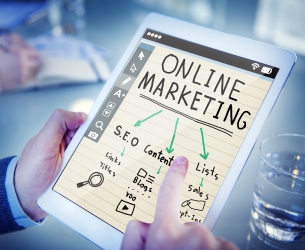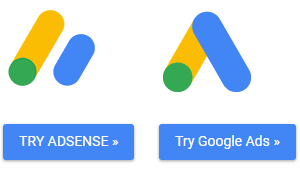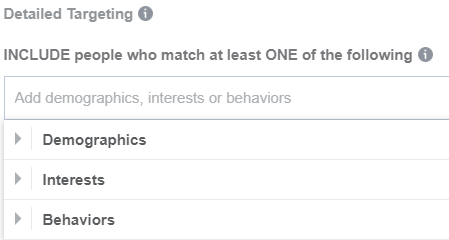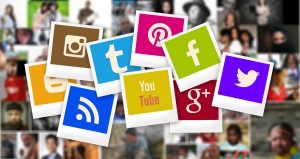
Side gigs are becoming the new norm for many people fighting to make it today. Some work for multiple employers, others try to use their talents to create new companies. Approximately half who do the latter fail within the first 5 years, but the memory of the Great Recession is fresh in our minds, so we forge ahead to try and set groundwork for the next rainy day anyway.
Why is the failure rate so high though? There are a number of possible reasons, but one of the more common ones is mismanaged online marketing. You might remember us touching on the value of online marketing during earlier discussions about social media and Google Ads, but do you know which of these tools is going to be the most important for your company’s success?
If not, then this post is the follow up piece you’ve been waiting for.
Jump ahead to:
Before investing your first cent into online marketing, know your market.
 This isn’t going to be as easy as “people who need ‘X’ products or services”, so grab a sheet of paper and a pen and be prepared to spend some time really thinking about this question. While mulling it over, don’t be surprised if you have to answer a few of these other questions first:
This isn’t going to be as easy as “people who need ‘X’ products or services”, so grab a sheet of paper and a pen and be prepared to spend some time really thinking about this question. While mulling it over, don’t be surprised if you have to answer a few of these other questions first:
- Which demographics (age groups, gender, etc.) are most likely to want what I offer?
- How quickly are they going to need my products or services?
- Where are they going to look to find me?
- Where should I look to find them?
- Is visual presentation a key selling point?
- How profitable is each new client?
While not a comprehensive list, this batch of questions should give you good starting points to start researching your market and its trends in some detail. If you feel like you’re still coming up short, take a look at what your most successful competition is doing as an example, then work to develop a strategy that builds on their strengths and surpasses them.
To that end, some mediums are going to be far more powerful than others for helping you achieve this goal – especially on the Internet. Knowing the common online marketing tools and what they are best suited to achieve will be key to your online marketing strategy, helping you spend wisely, target precisely, and achieve the best possible chance of success.
Pay-per-click (PPC) tools like Google Ads (formerly AdWords) & Google AdSense are great for urgent needs.

Without this picture or their help article, would you have known which was which?
PPC is pretty self-explanatory. You set up an ad, and you pay a given amount for each time someone clicks it. Google Ads lets you create advertisements for use directly on Google and its partner sites, and AdSense places advertisements on websites that have agreed to publish them in exchange for being paid for each click their website generates.
These types of ads also tend to be fairly costly depending on your industry. As a result, you need to ensure your company meets the following criteria:
- Your products/services fill an immediate need
- New clients are significantly profitable
- Your products/services prohibit comparison shopping
Perfect examples of industries that fulfill these criteria are 24-hour plumbers, locksmiths, and bail bondsmen. You’re only reaching out to these people at 3:00 am because you’ve become involved in a catastrophe that is causing active harm, stranding you somewhere, or placing you in an extremely undesirable situation – often more than one of the above.
More importantly, when you’re looking for someone in one of these emergency situations, you’re probably going to call the first one you find who is available, and deal with the consequences later. Money isn’t a primary concern here – fixing the problem as soon as humanly possible is.
Conversely, if your situation isn’t an emergency, you’re more likely to explore your available options and do research to find the best one for your needs and wallet. Internet marketers, financial planners, and contractors are a few industry examples where PPC is going to be a money sink that leaves you in the red.
Looking for surgical precision in your online marketing? Try Facebook ads.
Facebook has evolved dramatically over the last decade, transforming from its humble beginnings as a social network for college students into a worldwide phenomenon that is used by over 2 billion users each month to share updates, pictures, videos and more. Part of this shift brought companies into the fold, and advertising opportunities arrived hand in hand with them.

While this shift was annoying for many personal accounts, it has also been exactly what certain niches needed to survive and thrive. In addition to the typical demographic settings many providers offer (age, gender, location, etc.), Facebook’s data partnerships allow you to really focus on specific details about the audience you want to attract. A small handful of these include:
- Purchase habits
- Life events
- Personal interests
- Political affiliations
- Education level
- Travel habits
No wonder the data breach in 2018 was so concerning.
You want to market to people between the ages of 45-55 who are Cleveland Browns fans making an average income within 50 miles? Facebook’s online marketing can make it happen. Young democrats who love buying funny t-shirts? Facebook knows who they are too. The more specific your niche, the more likely you are to succeed here.
While Facebook’s arsenal of information sounds like the perfect interface for online marketing, there are a few drawbacks to consider as well:

First, Facebook isn’t a conventional marketplace like Amazon. People don’t log into Facebook thinking “I need to buy a new laptop, cat toys, and a birthday present for my cousin.” As a result, your ad is really going to have to be something special, something that really jumps off the page to pry open your audiences’ wallets.
Great examples of this can be found with recreational niches like t-shirt companies. My feed is littered with people sharing their clever designs, and every one is specifically tailored to zodiac signs, relationships, and hobbies that are directly related to the people sharing them. I play a lot of board games, so I frequently see Kickstarter campaigns for those show up to similarly entice me.
Second, if your business isn’t very visually intensive, it’s going to be very difficult to (and I hate this phrase) make your ad pop. This is often especially true if your niche also sells a lot of high ticket services/products outside the recreational sphere.
That’s not to say non-recreational companies with the right niche can’t or won’t succeed – quite the opposite – but they serve as one of the more common business models that achieve their goals. At worst, you’ll still get some brand awareness, which isn’t nothing, but your return on investment is likely to be higher elsewhere.
Creative, artistic businesses thrive on Instagram and Pinterest.
Instagram and Pinterest are two platforms with very different takes on the visual social media experience. Instagram is a bit more conventional, bundling the ability to showcase photos and videos with your network along with an extensive suite of filters and editing tools for the former. It’s a fairly conventional approach, which isn’t surprising as they’re owned by Facebook.
Pinterest takes a very different approach by making discovery the name of the game. You name your picture and add a caption, and it shows up in searches without the aid of hashtags or the requirement of interaction. Users find your pictures, pin them to their boards, and group them with other content on boards to help organize it.
Best of all, Pinterest images link back to their original source, which can help you drive traffic to increase interest in your offerings and improve your SEO. Between this and the ability to use “buyable pins” to make purchases from the app, it’s no wonder Pinterest is such an effective conversion tool – particularly in the realm of visual social media.
Not one to be left in the dust, Instagram has stepped up its game in this regard over the last few years. Their paid advertising system covers for its primary marketing weakness, the inability to put links into ordinary posts, allowing it to step into the marketing limelight alongside its primary competitor.

Such is the power of visual social media.
Naturally, this makes both platforms essential for any business model that thrives on visuals. A few examples of these include:
- Artists
- Models
- Landscapers
- Interior decorators
- Contractors
- Restaurants
This is especially true if women are a key demographic among your customers. While Instagram skews very slightly toward women, approximately 70-80% of Pinterest’s users are female, depending on who you ask.
One last item of note for these visual environments is the power of influencers, or people who have enormous followings and clout within social media. These people are often the unsung heroes of overnight success stories, playing a key role in facilitating the big break you’ve been working toward.
Unfortunately, the odds that you’ll be discovered and advertised organically are long. Because of this, you’ll almost always have to take the initiative if you want to try securing a portion of this influence for your company. Even if you aren’t successful, knowing who the influencers in your industry are is still beneficial, and may play a role in helping you explore opportunities further down the road.
Even if social advertising is not for you, social media still matters for your online marketing.
As you’ve probably noticed up to this point, I’ve been careful to discuss specific industries in my online marketing examples, and quite a few haven’t been brought up. This isn’t by accident – PPC and paid social advertising simply aren’t going to make every industry or market major money right now.
The important thing to remember when I say this, however, is that social advertising is not the same as social presence. You still need to be involved with at least one or two major social media platforms if you’re running a business for two primary reasons.

The first is one I’ve touched on periodically before, and that’s the SEO benefit. Engaged social media accounts with high quality updates encourage website traffic and usually result in ranking improvement. For those who really want to dig into the data, you can check out this experiment investigating Twitter’s impact on promoted blog posts.
Your second benefit is going to be akin to the benefits older websites sought out when creating testimonial pages. Younger buyers (think 35 or younger) are likely to look for some form of social media involvement before they place their trust in a company, as it is a sign of legitimacy, a place to find user experiences, and a way for them to engage with you.
Not a bad package for something that doesn’t take long to set up, that’s for sure.
Before you focus on online marketing, make sure you’re established online.
In other words, make sure you’ve got an amazing website to refer people to! If you don’t have a business website you’d be proud to show off, give us a call at 319-229-5225. We’ll help you get this core foundation for your online presence in place so you can get the maximum bang for your buck when you start employing your advertising budget!

Braden is one of the founders of Midwest Websites, and has been professionally writing and developing websites for over 7 years. His blog posts often take an experience from his life and showcase lessons from it to help you maximize online presence for your business.

